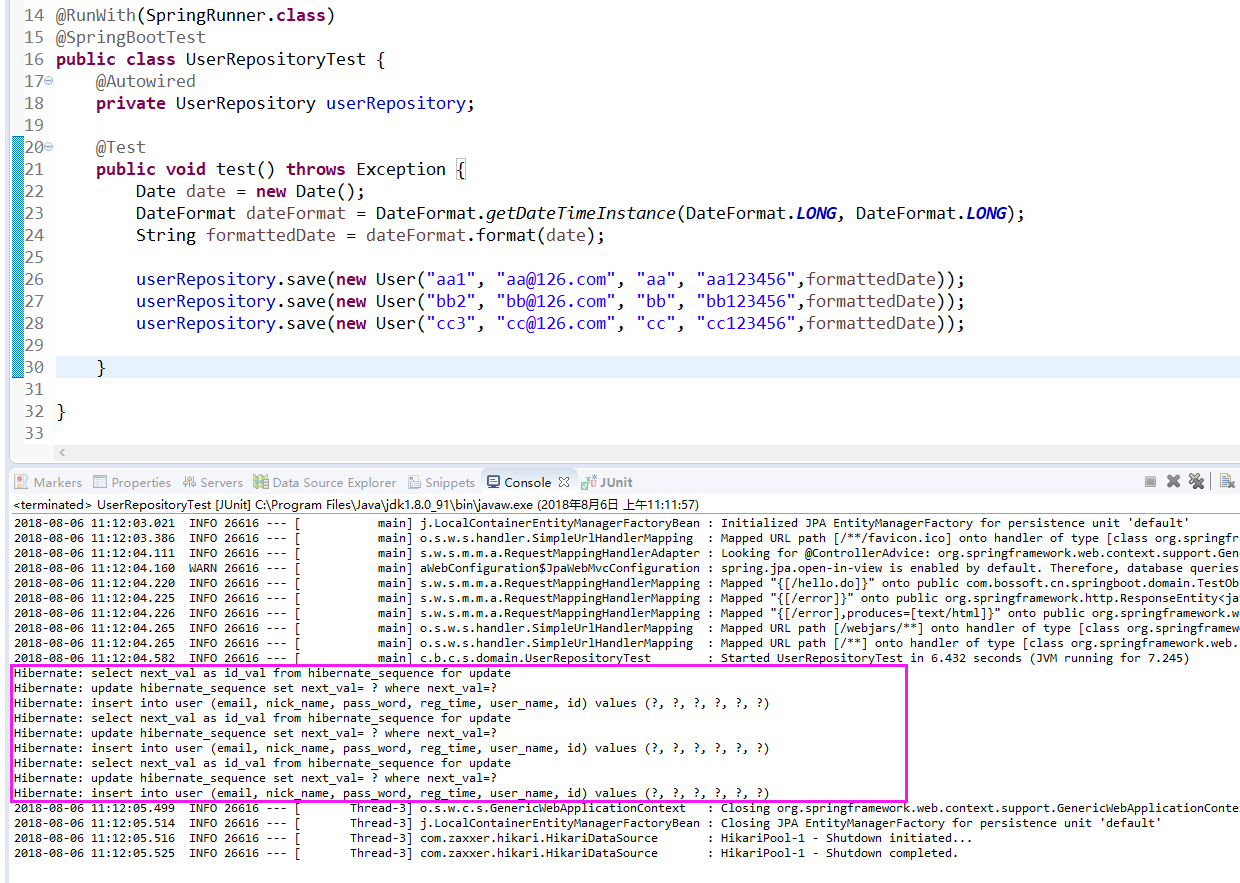Spring boot初级教程 :《SpringBoot入门教学篇①》,方便大家快速入门、了解实践Spring boot特性,本文介绍springBoot的web开发
web开发
spring boot web开发非常的简单,其中包括常用的json输出、filters、property、log等。
json 接口开发
在以前的spring 开发的时候需要我们提供json接口的时候需要做那些配置呢?
添加 jackjson 等相关jar包
配置spring controller扫描
对接的方法添加@ResponseBody
就这样我们会经常由于配置错误,导致406错误等等,spring boot如何做呢,只需要类添加 @RestController 即可,默认类中的方法都会以json的格式返回。
自定义Filter
我们常常在项目中会使用filters用于录调用日志、排除有XSS威胁的字符、执行权限验证等等。Spring Boot自动添加了OrderedCharacterEncodingFilter和HiddenHttpMethodFilter,并且我们可以自定义Filter。
两个步骤:
实现Filter接口,实现Filter方法
添加@Configurationz 注解,将自定义Filter加入过滤链
代码示例:
import java.io.IOException; import javax.servlet.Filter; import javax.servlet.FilterChain; import javax.servlet.FilterConfig; import javax.servlet.ServletException; import javax.servlet.ServletRequest; import javax.servlet.ServletResponse; import javax.servlet.http.HttpServletRequest; import org.apache.catalina.filters.RemoteIpFilter; import org.springframework.boot.web.servlet.FilterRegistrationBean; import org.springframework.context.annotation.Bean; import org.springframework.context.annotation.Configuration; @Configuration public class WebConfiguration { @Bean public RemoteIpFilter remoteIpFilter() { return new RemoteIpFilter(); } @Bean public FilterRegistrationBean testFilterRegistration() { FilterRegistrationBean registration = new FilterRegistrationBean(); registration.setFilter(new MyFilter()); registration.addUrlPatterns("/*"); registration.addInitParameter("paramName", "paramValue"); registration.setName("MyFilter"); registration.setOrder(1); return registration; } public class MyFilter implements Filter { @Override public void destroy() { // TODO Auto-generated method stub } @Override public void doFilter(ServletRequest srequest, ServletResponse sresponse, FilterChain filterChain) throws IOException, ServletException { HttpServletRequest request = (HttpServletRequest) srequest; System.out.println("this is MyFilter,url :"+request.getRequestURI()); filterChain.doFilter(srequest, sresponse); } @Override public void init(FilterConfig arg0) throws ServletException { // TODO Auto-generated method stub } } }
自定义Property
在web开发的过程中,我经常需要自定义一些配置文件,如何使用呢?
配置在application.properties中。
com.bosssoft.title=springBoot测试
com.bosssoft.description=测试配置文件
自定义配置类
import org.springframework.beans.factory.annotation.Value; public class BossProperties { @Value("${com.bosssoft.title}") private String title; @Value("${com.bosssoft.description}") private String description; public String getTitle() { return title; } public void setTitle(String title) { this.title = title; } public String getDescription() { return description; } public void setDescription(String description) { this.description = description; } }
log配置
配置输出的地址和输出级别:
logging.path=/user/local/log logging.level.com.favorites=DEBUG logging.level.org.springframework.web=INFO logging.level.org.hibernate=ERROR
path为本机的log地址,logging.level 后面可以根据包路径配置不同资源的log级别。
数据库操作
在这里我重点讲述mysql、spring data jpa的使用,其中mysql 就不用说了大家很熟悉,jpa是利用Hibernate生成各种自动化的sql,如果只是简单的增删改查,基本上不用手写了,spring内部已经帮大家封装实现了。
下面简单介绍一下如何在spring boot中使用。
1、添加相jar包
<dependency>
<groupId>org.springframework.boot</groupId>
<artifactId>spring-boot-starter-data-jpa</artifactId>
</dependency>
<dependency>
<groupId>mysql</groupId>
<artifactId>mysql-connector-java</artifactId>
</dependency>
2、添加配置文件
spring.datasource.url=jdbc:mysql://localhost:3306/springboot spring.datasource.username=root spring.datasource.password=123456 spring.datasource.driver-class-name=com.mysql.jdbc.Driver spring.jpa.properties.hibernate.hbm2ddl.auto=update spring.jpa.properties.hibernate.dialect=org.hibernate.dialect.MySQL5InnoDBDialect spring.jpa.show-sql= true
其实这个hibernate.hbm2ddl.auto参数的作用主要用于:自动创建|更新|验证数据库表结构,有四个值:
1.create: 每次加载hibernate时都会删除上一次的生成的表,然后根据你的model类再重新来生成新表,哪怕两次没有任何改变也要这样执行,这就是导致数据库表数据丢失的一个重要原因。
2.create-drop :每次加载hibernate时根据model类生成表,但是sessionFactory一关闭,表就自动删除。
3.update:最常用的属性,第一次加载hibernate时根据model类会自动建立起表的结构(前提是先建立好数据库),以后加载hibernate时根据 model类自动更新表结构,即使表结构改变了但表中的行仍然存在不会删除以前的行。
要注意的是当部署到服务器后,表结构是不会被马上建立起来的,是要等应用第一次运行起来后才会。
4.validate :每次加载hibernate时,验证创建数据库表结构,只会和数据库中的表进行比较,不会创建新表,但是会插入新值。
dialect 主要是指定生成表名的存储引擎为InneoDB show-sql 是否打印出自动生产的SQL,方便调试的时候查看。
3、添加实体类和Dao
@Entity public class User implements Serializable { private static final long serialVersionUID = 1L; @Id @GeneratedValue private Long id; @Column(nullable = false, unique = true) private String userName; @Column(nullable = false) private String passWord; @Column(nullable = false, unique = true) private String email; @Column(nullable = true, unique = true) private String nickName; @Column(nullable = false) private String regTime; public User() { super(); } public User(String email, String nickName, String passWord, String userName, String regTime) { super(); this.email = email; this.nickName = nickName; this.passWord = passWord; this.userName = userName; this.regTime = regTime; } public Long getId() { return id; } public void setId(Long id) { this.id = id; } public String getUserName() { return userName; } public void setUserName(String userName) { this.userName = userName; } public String getPassWord() { return passWord; } public void setPassWord(String passWord) { this.passWord = passWord; } public String getEmail() { return email; } public void setEmail(String email) { this.email = email; } public String getNickName() { return nickName; } public void setNickName(String nickName) { this.nickName = nickName; } public String getRegTime() { return regTime; } public void setRegTime(String regTime) { this.regTime = regTime; } }
dao只要继承JpaRepository类就可以,几乎可以不用写方法,还有一个特别有尿性的功能非常赞,就是可以根据方法名来自动的生产SQL,比如findByUserName 会自动生产一个以 userName 为参数的查询方法,比如 findAlll 自动会查询表里面的所有数据,比如自动分页等等。
Entity中不映射成列的字段得加@Transient 注解,不加注解也会映射成列。
import java.util.List; import org.springframework.data.jpa.repository.JpaRepository; public interface UserRepository extends JpaRepository<User, Long> { User findByUserName(String userName); User findByUserNameOrEmail(String userName, String email); List<User> getUsersByUserName(String userName); }
4、测试
@RunWith(SpringRunner.class) @SpringBootTest public class UserRepositoryTests { @Autowired private UserRepository userRepository; @Test public void test() throws Exception { Date date = new Date(); DateFormat dateFormat = DateFormat.getDateTimeInstance(DateFormat.LONG, DateFormat.LONG); String formattedDate = dateFormat.format(date); userRepository.save(new User("aa1", "aa@126.com", "aa", "aa123456",formattedDate)); userRepository.save(new User("bb2", "bb@126.com", "bb", "bb123456",formattedDate)); userRepository.save(new User("cc3", "cc@126.com", "cc", "cc123456",formattedDate)); /*Assert.assertEquals(9, userRepository.findAll().size()); Assert.assertEquals("bb", userRepository.findByUserNameOrEmail("bb", "cc@126.com").getNickName()); userRepository.delete(userRepository.findByUserName("aa1"));*/ } }
当让 spring data jpa 还有很多功能,比如封装好的分页,可以自己定义SQL,主从分离等等,这里就不详细讲了。


thymeleaf模板
Spring boot 推荐使用来代替jsp,thymeleaf模板到底是什么来头呢,下面来聊聊。
Thymeleaf 介绍
Thymeleaf是一款用于渲染XML/XHTML/HTML5内容的模板引擎。类似JSP,Velocity,FreeMaker等,它也可以轻易的与Spring MVC等Web框架进行集成作为Web应用的模板引擎。与其它模板引擎相比,Thymeleaf最大的特点是能够直接在浏览器中打开并正确显示模板页面,而不需要启动整个Web应用。
好了,你们说了我们已经习惯使用了什么 velocity,FreeMaker,beetle之类的模版,那么到底好在哪里呢? 比一比吧 Thymeleaf是与众不同的,因为它使用了自然的模板技术。这意味着Thymeleaf的模板语法并不会破坏文档的结构,模板依旧是有效的XML文档。模板还可以用作工作原型,Thymeleaf会在运行期替换掉静态值。Velocity与FreeMarker则是连续的文本处理器。 下面的代码示例分别使用Velocity、FreeMarker与Thymeleaf打印出一条消息:
Velocity: <p>$message</p> FreeMarker: <p>${message}</p> Thymeleaf: <p th:text="${message}">Hello World!</p>
注意,由于Thymeleaf使用了XML DOM解析器,因此它并不适合于处理大规模的XML文件。
URL
URL在Web应用模板中占据着十分重要的地位,需要特别注意的是Thymeleaf对于URL的处理是通过语法@{…}来处理的。Thymeleaf支持绝对路径URL:
<a th:href="@{http://www.thymeleaf.org}">Thymeleaf</a>
条件求值
<a th:href="@{/login}" th:unless=${session.user != null}>Login</a>
for循环
<tr th:each="prod : ${prods}"> <td th:text="${prod.name}">Onions</td> <td th:text="${prod.price}">2.41</td> <td th:text="${prod.inStock}? #{true} : #{false}">yes</td> </tr>
WebJars
WebJars是一个很神奇的东西,可以让大家以jar包的形式来使用前端的各种框架、组件。
什么是WebJars
什么是WebJars?WebJars是将客户端(浏览器)资源(JavaScript,Css等)打成jar包文件,以对资源进行统一依赖管理。WebJars的jar包部署在Maven中央仓库上。
为什么使用
我们在开发Java web项目的时候会使用像Maven,Gradle等构建工具以实现对jar包版本依赖管理,以及项目的自动化管理,但是对于JavaScript,Css等前端资源包,我们只能采用拷贝到webapp下的方式,这样做就无法对这些资源进行依赖管理。那么WebJars就提供给我们这些前端资源的jar包形势,我们就可以进行依赖管理。
如何使用
1、 WebJars主官网 查找对于的组件,比如bootstrap:
<dependency>
<groupId>org.webjars.bower</groupId>
<artifactId>bootstrap</artifactId>
<version>3.0.3</version>
</dependency>
2、页面引入
<link th:href="@{/webjars/bootstrap/3.3.6/dist/css/bootstrap.css}" rel="stylesheet"></link>
就可以正常使用了!